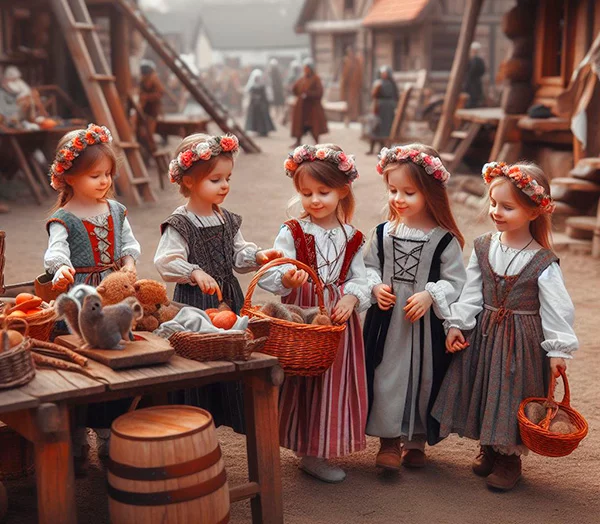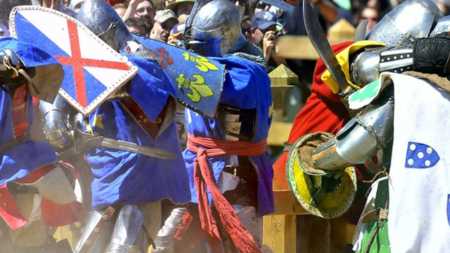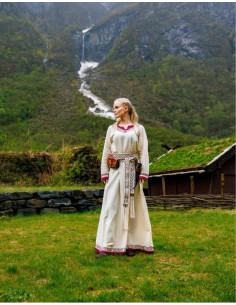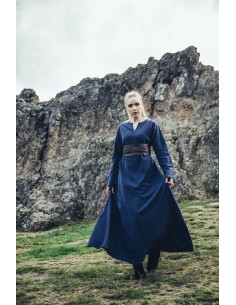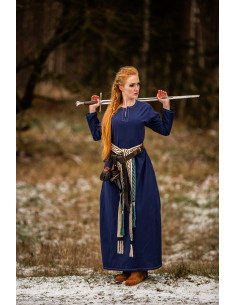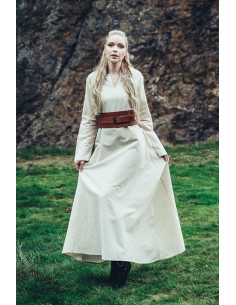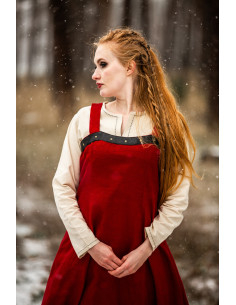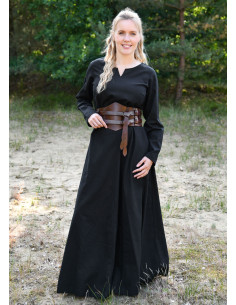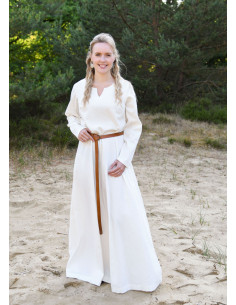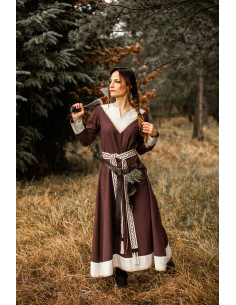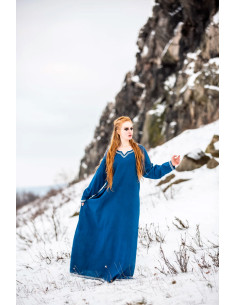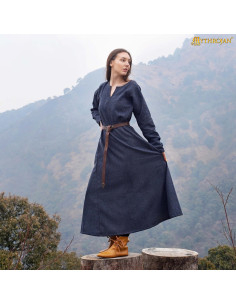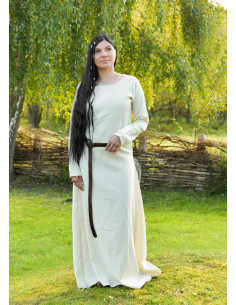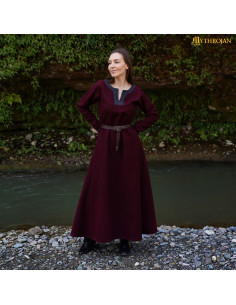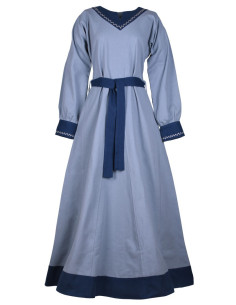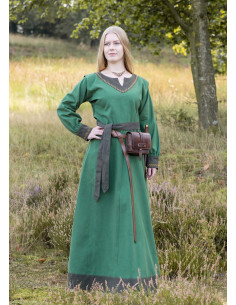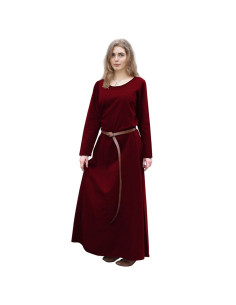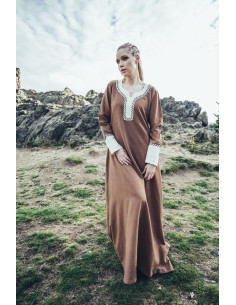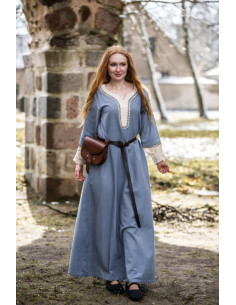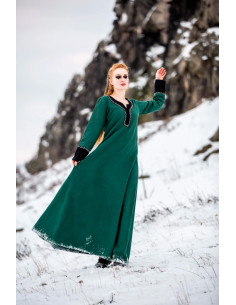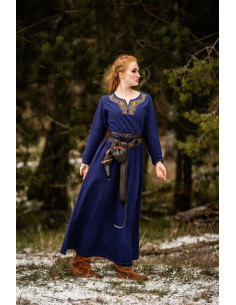Vestidos vikingos
Viking dress with decorative borders, Ingrid model, burgundy color
Styles and Cuts of Viking Dresses for Every Occasion
The range of Viking dresses we offer spans from simple, functional lines to long, elaborately worked designs, intended for reenactments, celebrations, and everyday wear with a historic feel. You will find models such as the Helga women's Viking dress in black or red, and the Lagertha model Viking dress in natural‑green or natural‑red two‑tone, which stand out for their feminine cuts and elegant drape. Long dresses like the Freya in blue, sand or green provide a majestic presence ideal for ceremonies, while lighter options like the Lightweight Medieval Milla women's dress in natural white or black combine authenticity with comfort.
We also have alternatives in different lengths and openings: the long Aslaug Viking dress and the long Afra Viking dress in wine red demonstrate how a long pattern can flatter traditional silhouettes. Linen or cotton versions, such as the Helga women's Viking linen dress in several colors and the Valdis cotton Viking dress in natural white or midnight blue, offer different textures and drapes that let you adapt the style to your event. Overall, our selection of Viking dresses makes it easy to choose between historical austerity and contemporary details.
Materials and Fabrics: Linen, Cotton and Wool in Viking Dresses
Fabric choice is key in Viking dresses: linen brings freshness and a natural drape perfect for temperate climates; for example, the Helga women's Viking linen dress in burgundy, blue or natural and the Alena Viking overdress in olive linen show the rustic elegance of linen. Cotton, as in the Valdis cotton Viking dress in natural white or midnight blue, is versatile, easy to wash and comfortable for recurring use. Wool, present in models like the Celeste basic wool Viking dress in natural color or the Astrid wool version, provides warmth and structure for cold seasons or winter reenactments.
Each fabric determines care and comfort: linen softens over time and with washing, cotton keeps colors more intense and is practical for everyday garments, while wool requires specific care but delivers historical authenticity and thermal insulation. In our Viking dresses you will find combinations and linings designed to balance aesthetics and functionality: from lightweight dresses like the Milla model to more imposing pieces like the long Freya or Aslaug, adapted to different materials and contexts.
How to Choose the Right Size and Fit for Your Viking Dresses
Selecting the correct size in Viking dresses involves considering both your personal measurements and the type of fit you want: some models, like Helga or Jona, are typically designed with a more fitted torso and a full skirt, allowing the use of belts to cinch the waist. Others, such as the traditional Viking dress or the Astrid Viking dress, offer straighter lines for a comfortable fit. For historical reenactments it is recommended to keep some room for underlayers or tunics, while for formal events a more fitted cut enhances the figure.
Check the specific size guide for each product and take your bust/chest, waist and hip measurements before choosing. Bear in mind that fabrics like linen and cotton may give slightly with wear, while wool offers less elasticity but better thermal adaptation. Models like the Jona Viking dress in various colors and the Milla women's Viking dress in mustard yellow show how pattern and fabric influence sizing: if you are between two sizes, choosing the larger one makes it easier to layer and move without losing historical proportion.
Styling and Combinations with Viking Dresses
Viking dresses allow multiple combinations depending on the occasion: for a historical reenactment pair a long dress like Freya or Aslaug with an Alena overdress, traditional brooches and a wide belt; earth and natural tones stand out in rustic settings. For a more festive look, the long Afra Viking dress in wine red or the Lagertha model in natural‑red two‑tone add drama. If you’re after a more contemporary approach, add leather boots, a short cloak and metal accessories reminiscent of fibulae or buckles.
Details matter: decorative edges on the Ingrid model in burgundy or the finishes on the Frida women's Viking dress in midnight gray give the garment character. Think in layers: a lightweight underdress like the Lightweight Medieval Milla under an overdress creates depth. Accessories should balance the silhouette and the fabric; for example, aged leather belts with linen or simple brooches with cotton dresses. In this way, Viking dresses adapt easily to ceremonies, Viking fairs, photo shoots and streetwear with a Nordic vibe.
Care and Practical Maintenance for Your Viking Dresses
Preserving a Viking dress depends on the fabric: linen and cotton should be washed gently on delicate cycles with mild detergents to maintain color and fiber; avoid strong bleaches. For wool, hand washing or a wool program and laying flat to dry are the best practices to prevent deformation and shrinkage. Models like the Valdis cotton Viking dress or the Astrid Viking dress in wool require attention to the care labels on each piece, and a good maintenance plan prevents pilling and wear in high‑friction areas.
Store your Viking dresses in dry, ventilated places, preferably in fabric covers to protect them from dust and moths if they include wool. Iron at temperatures appropriate to the fabric and use steam to restore the natural drape without damaging decorative edges, as on the Ingrid model. Simple repairs to seams or reinforcing eyelets extend the garment’s life. With proper care, pieces like the long Freya Viking dress or the Helga women's Viking dress will retain their shape and color for long periods.
What materials are the Viking dresses in this category made from?
Our Viking dress collection mainly includes linen, cotton and wool, with combinations and linings depending on the model. For example, the Alena Viking overdress is in linen, the Valdis cotton Viking dress uses good‑quality cotton and the Astrid Viking dress is available in wool versions for greater warmth. Each material brings different texture, drape and comfort: linen is fresh and rustic, cotton is easy to care for and wool provides insulation and historical authenticity.
How do I choose between linen, cotton and wool for my Viking dress?The choice depends on use and season: linen is ideal for temperate/summer climates due to its breathability, cotton works well for frequent use and is practical to wash, while wool is recommended in cold climates or for reenactments that seek greater historical fidelity. Also consider the model: long dresses like Freya or Aslaug in linen offer an elegant drape, and models like Astrid or Celeste in wool provide structure and warmth. Think about layering and whether you will need a lining or overdress.
Are the Viking dresses appropriate for historical reenactments and medieval events?Yes, many of our Viking dresses are designed with patterns and materials inspired by historical garments, so they are suitable for reenactments, Viking fairs and medieval events. Models like the traditional Viking dress or the Astrid Viking dress in wool offer a faithful aesthetic, while pieces like the Lagertha model or the long Freya Viking dress allow for dramatic presence in ceremonies. For greater authenticity, combine them with overdresses, brooches and belts appropriate to the period.
How should I pair accessories with a Viking dress for a balanced look?Accessories that work best include aged leather belts, fibula‑style brooches, cloaks and simple jewelry in bronze or oxidized silver. An overdress like the Alena adds volume and allows for more visible brooches; embroidered models like Ingrid accept more discreet accessories. For modern events, add leather boots and a short cloak. The key is to respect the dress’s color palette — for example, natural tones, burgundy or midnight blue — and balance ornaments without overloading the silhouette.
How do I wash and care for a linen or cotton Viking dress without damaging it?For linen and cotton, use delicate cycles or hand wash with cold or warm water and mild detergents. Avoid bleach and aggressive spin cycles; air dry and, if ironing, use steam or a medium temperature to preserve fibers and color. Decorative edges and appliqués need extra care: turn the garment inside out before washing and pad delicate areas. Checking the product label, as with the Helga women's Viking linen dress or the Valdis cotton Viking dress, is essential to follow specific recommendations.
Do Viking dresses come in modern sizes or historical sizing?Our collection adapts historical patterns to modern sizes to make purchasing easier, while maintaining cuts and proportions that respect the traditional aesthetic. Each product includes a size guide with bust/chest, waist and hip measurements; models like Jona, Milla or Helga usually offer fits that allow for belts or under‑tunics. If you are unsure between sizes, choose the larger one for layering or reenactments; for a more defined fit at formal events, the closer fitting size may be appropriate.
What differences are there between models like Helga, Freya and Lagertha?Each model corresponds to a different pattern and purpose: Helga tends to be versatile, available in linen or various colors and designed for everyday wear or events; Freya is usually a long dress with a formal presence, ideal for ceremonies; Lagertha offers two‑tone details and cuts that enhance the silhouette, with a more decorative feel. Other models, like Valdis in cotton or Astrid in wool, bring variations in material and structure. Check the product sheet to see measurements, fabrics and styling suggestions.
What are the advantages of choosing an overdress like the Alena model?The Alena Viking overdress in olive linen is perfect for adding layers and volume without sacrificing mobility. An overdress lets you play with contrasts of color and texture, protects the underdress from wear and adds authenticity in reenactments. It also facilitates combinations with belts and brooches and adapts to different temperatures: wear it over a lightweight dress like the Milla in summer or over a tunic and wool dress in winter for added warmth.
Explore our collection of Viking dresses and find the model that connects with your historical style: from Helga and Freya to Lagertha and Valdis. Shop online securely, choose your size with our guide and create unique looks for reenactments, events or everyday wear.



